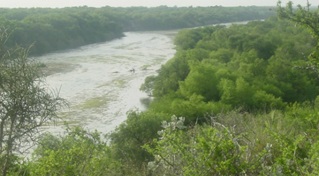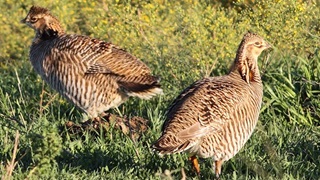From bombs to birds: The transformation of Caddo Lake wetlands
Volunteers hope international birders will flock to Texas wildlife refuge
Pausing at the edge of Caddo Lake in east Texas, a nature guide informs a school group that the flora around them is a bird’s paradise, attracting more than 220 species to the area.
Suddenly, a bright yellow prothonotary warbler alights nearby—a truly serendipitous sight.
“Our mouths opened, our eyes opened, and we stared at it,” recalls Gary Lewis Endsley, volunteer guide and president of the Friends of Caddo Lake National Wildlife Refuge (NWR). “It was a tremendous thrill for all involved. It made the point. If you’re in the right place at right time, you can see some wonderful things.”
Not too long ago, more than birds lit the skies of Caddo Lake, a 30,000-acre body of water bisected by the Texas-Louisiana state line. From 1942 to 1997, the site housed the Longhorn Army Ammunition Plant, which produced explosives and missiles and had 451 buildings at its peak. In 1988, the plant made history by becoming the first U.S. facility to disassemble missiles, marking the beginning of the end of the nuclear arms race.
During the time of the plant, the wetlands remained vital to birds and waterfowl. Located where the Mississippi Flyway meets the Central Flyway, the region around Caddo Lake serves as a way station for birds during their migrations—a function that prompted the territory’s designation as a national wildlife refuge in 2000.
The Caddo Lake NWR is relatively young. But with help from an $11,500 grant from Enbridge through the National Fish and Wildlife Foundation’s (NFWF) Refuge Friends program, the not-for-profit group hopes to bring worldwide recognition to the refuge as a destination for birding, one of North America’s fastest growing hobbies.
The Caddo Lake NWR will use the Enbridge grant money to launch an e-bird kiosk later this year in the refuge’s visitor center. Visitors will learn which birds have been spotted on the refuge, and the approximate locations. They’ll listen to sounds to help identify species. And they can track their own sightings and upload photos.
“The neat thing about the e-bird kiosk is that people all over the world can go online and see what we’re bringing through this flyway,” says Stella Barrow, president of the Cypress Basin Master Naturalists, a group that works closely with the Friends of Caddo Lake.
The Enbridge grant will also help the Friends and Master Naturalists build an accessible trail, featuring a three-sided bird blind with a roof and seating, and refurbish a second trail and blind.
“Visitors have described Caddo Lake as ‘the most beautiful lake you will ever see,’ ” says Cindy Finch, who manages Enbridge’s U.S. community investment activities. “These upgrades will attract international birders who will come to see species they know have been spotted in the area.”
Endsley and Barrow also anticipate that the improvements will help their groups attract new members. Endsley compares it to a snowball rolling downhill: “As we improve our offerings, we’ll increase visitors and membership to revitalize the Friends.”









